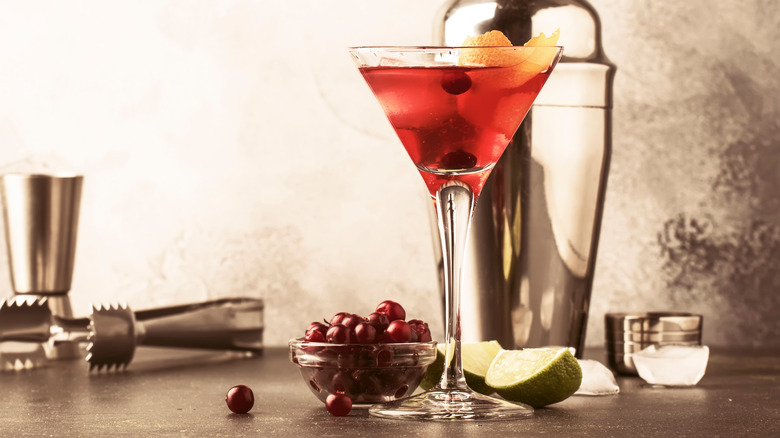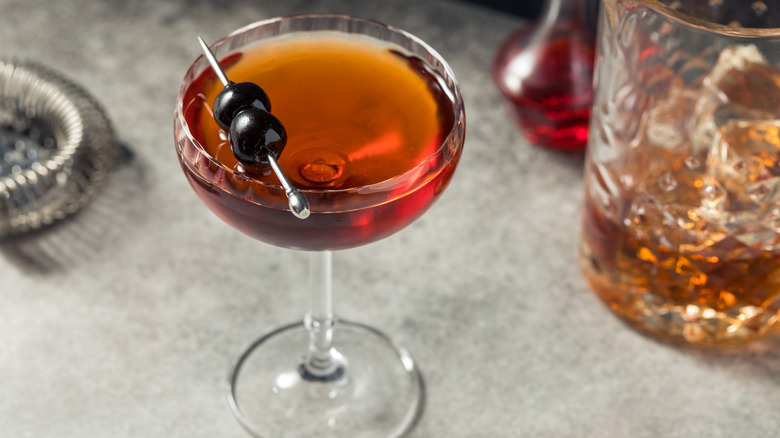The Differences Between A Manhattan And Cosmopolitan Cocktail
Those ladies on "Sex and the City" sure loved sipping their Manhattans ... or were they Cosmopolitans? If you have trouble remembering which is which, the glamorous, urban names of each drink might be to blame. But the truth is, a Manhattan and a Cosmopolitan could hardly be more different. Although they may be served in similar glassware, and both have a reddish hue, the two cocktails don't have a single ingredient in common and offer wildly different flavor profiles.
The recipe for a classic Manhattan calls for just three ingredients: rye whiskey, sweet vermouth, and Angostura bitters, garnished with a cocktail cherry. It's a boozy, spirit-forward drink with a heavy sweetness, traditionally served as a pre-dinner aperitif. The recipe for a Cosmopolitan, meanwhile, creates a fruity, light, and refreshing banger from the late 1980s-early 1990s, consisting of lemon-flavored vodka, cranberry juice, lime juice, and the orange-flavored liqueur triple sec. It's much sweeter and fruitier than it is booze-forward, making it an approachable, easy sipper, even for those who don't love the taste of alcohol.
The two drinks are also separated by an age difference of approximately 100 years, so it makes sense that they represent two very different approaches to cocktail-making. Still, both are famous enough today that you could walk into virtually any bar in the world and the bartender could make either one — just make sure you know which one you mean when you order.
First, there was Manhattan
The most famous, yet debunked, origin story for the Manhattan gave it pretty lofty ties to Western diplomacy: As the legend went, the cocktail was developed at a December 1874 party celebrating the election of New York Gov. Samuel James Tilden at the Manhattan Club in New York City. The drink was supposedly made especially for one Jennie Jerome, mother of Winston Churchill, who resided on the property. In reality, this myth is likely untrue. Lady Churchill would have been in Europe in December 1874, having just given birth to the future Prime Minister the previous month; and anyway, the Manhattan Club wasn't housed at the Jerome family property until 1899. But the island of Manhattan was, by all accounts, the drink's birthplace, with it likely being first mixed up at a downtown bar called the Manhattan Inn in the 1870s.
The reddish-brown drink balances sweet, bitter, and boozy flavors, all of which are smoothed out by giving the drink a quick stir with ice before serving, usually into a pre-chilled cocktail glass. Being such a simple, three-ingredient cocktail, it's not difficult to make, and is sure to please fans of rye — or anyone who just likes their drinks stiff.
How very Cosmopolitan
The Cosmopolitan, or Cosmo, on the other hand, came into being about a century after the Manhattan — and despite being much closer to recent memory, its origins are even more hotly contested. There's reasonable evidence that in the mid- to late-1980s, two different bartenders, Cheryl Cook in Miami, and Neal Murray in San Francisco, independently came up with a pink, cranberry vodka drink, and both happened to call it the Cosmopolitan. Other drink historians credit the pink drink's invention to the gay nightlife scene of Provincetown, Mass.; and the cocktail is often traced through several major LGBTQ communities on its climb to prominence, from clubs in Cleveland to the Life Café in Manhattan's Alphabet City district.
It's perhaps unsurprising that the fruity, hot-pink drink was later cemented in pop culture by iconic imbibers including Madonna and "Sex and the City" fictional protagonist Carrie Bradshaw. Regardless of who invented the drink, the rise of the Cosmo signified a watershed moment in the history of cocktails, when drinks that were fun and splashy both in appearance and taste were all the rage. And while ordering a Cosmo today might be a little more nostalgic than it is trendy, it's still sure to be tangy, a little sweet, and totally delicious.


